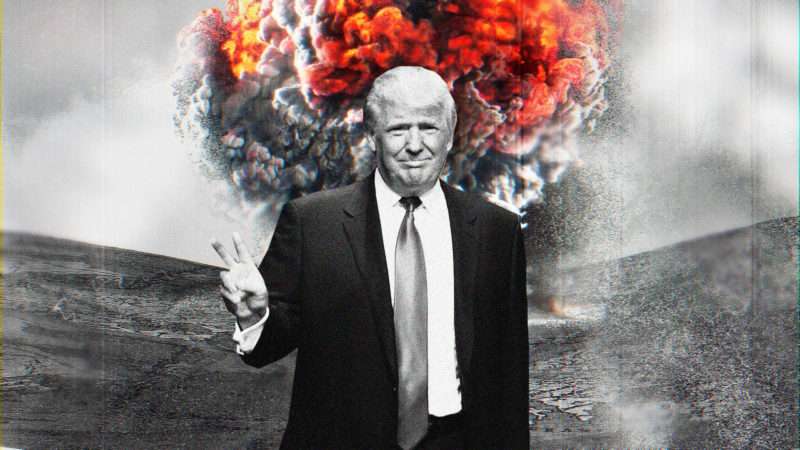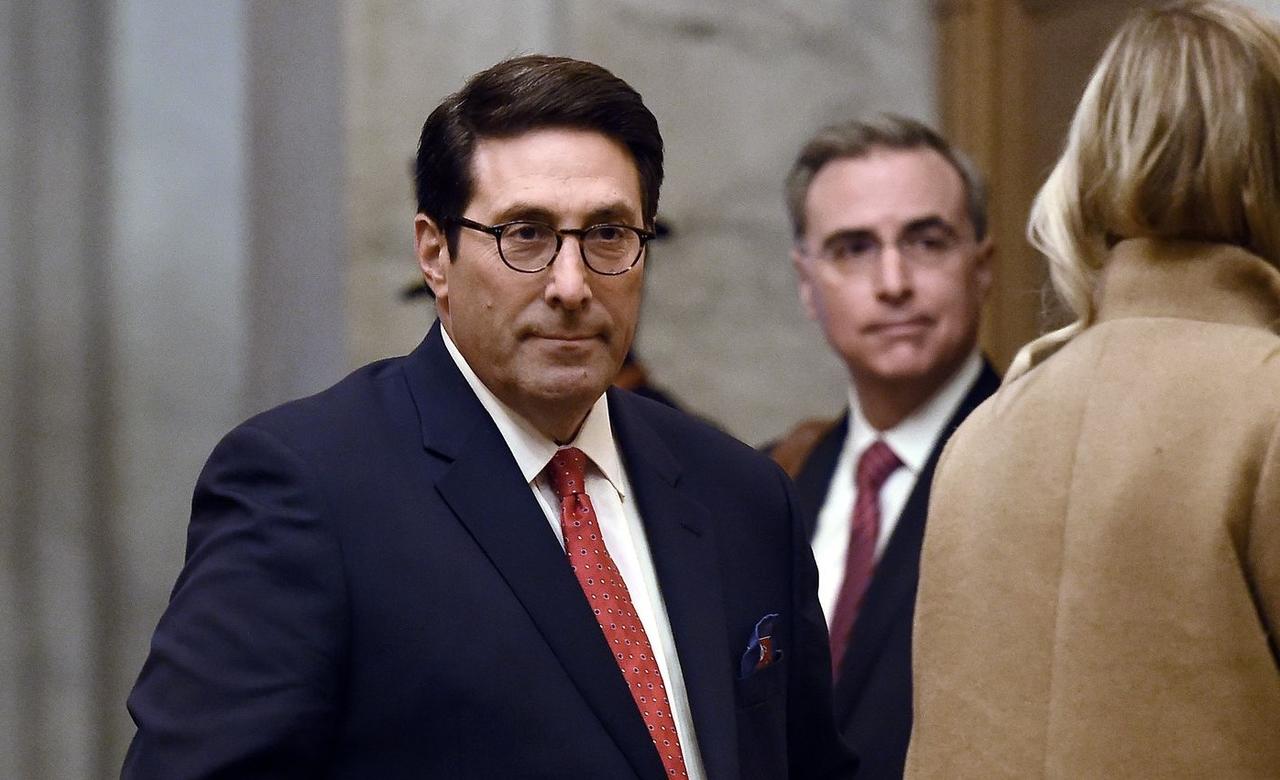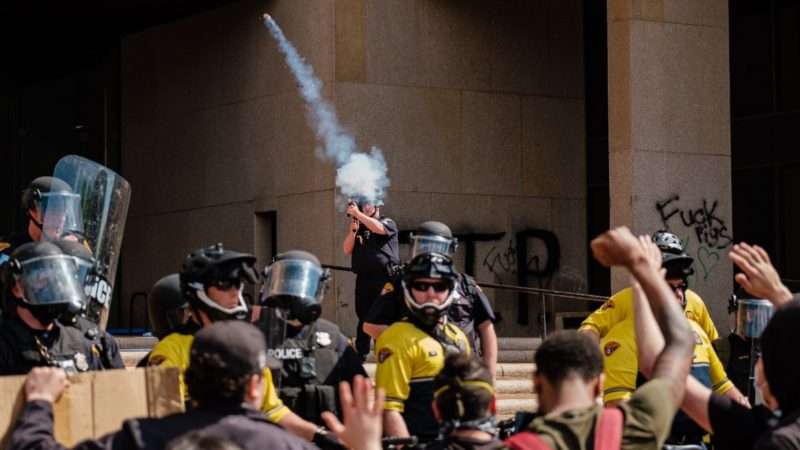
Donald Trump’s pitch to “Make America Great Again” included a commitment to rethinking America’s interventionist foreign policy.
“After the Cold War, our foreign policy veered badly off course,” then-candidate Trump told an audience at the Center for the National Interest in April 2016. “Logic was replaced with foolishness and arrogance, and this led to one foreign policy disaster after another.”
Trump’s promise to unwind America’s foreign commitments won the vote of some anti-war libertarians, who argued that, while many of his political views were odious, foreign policy mattered most.
“Donald [Trump] is a peacenik, practically, certainly compared to the war-mongering Hillary [Clinton],” libertarian economist Walter Block told the audience at a November 2016 debate over whether libertarians should support Trump, which was hosted by the Soho Forum.
On the campaign trail, Trump also attacked Clinton for voting to authorize the invasion of Iraq as a senator, for pushing for U.S. intervention in Libya as secretary of state, and for her hawkish approach to foreign policy in general.
“Almost everything [Hillary Clinton] has done in foreign policy has been a mistake, and it’s been a disaster,” Trump said in an October 2016 debate.
In a November 2016 Reason podcast, historian Thaddeus Russell made the case that Trump would prove to be the less interventionist alternative to Clinton.
“Whenever there’s a dictator or tyrant [America doesn’t] like in any part of the world, we are obligated to remove him,” Russell said. “Trump is the first president to call bullshit on that very claim…And in doing so, I think he may do great service for actual peace.”
But now that we’re ending his presidential term, do noninterventionists believe Trump actually has moved the world closer to peace?
“I think Trump has moved America considerably closer to peace,” says Russell. “At the very same time, he’s moved us into more wars. So it’s a terribly mixed bag.”
But Russell says that Trump’s rhetoric alone still was an important victory for the noninterventionist cause.
“He called into question the need for America to invade countries, to change their regimes and to stay there…Specifically, he called into question the Iraq war.”
Trump isn’t the first modern president to promise an end to foreign entanglements on the campaign trail only to double down on those commitments once in office. Candidate Barack Obama called the Iraq War “dumb” and promised to end it.
Obama temporarily withdrew troops from Iraq on Bush’s pre-negotiated timetable, but then re-intervened a few years later after ISIS filled the power vacuum. He also expanded the war on terror into several new countries and began personally ordering covert drone strikes, one of which killed a 16-year-old American, and another that killed at least 13 people headed to a wedding.
Even George W. Bush, who as president started the disastrous wars in Iraq and Afghanistan, ran against nation-building on the campaign trail.
“I just don’t think it’s the role of the United States to walk into a country and say, ‘We do it this way. So should you,'” Bush said in a 2000 debate.
Scott Horton, a popular anti-war podcast host and author of a book on the history of the war in Afghanistan, says modern presidents often campaign against war because it’s a popular position in the abstract.
“The American people want peace,” says Horton.
He agrees with Russell that Trump’s rhetorical attack on the foreign policy establishment, and specifically on Jeb Bush and the Iraq war, helped the anti-war cause.
“He really got the…Tea Party, Republican voters of America to finally admit that they were wrong to have supported George Bush,” says Horton.
But he says Trump is too impulsive to be reliably anti-war.
“The problem with Donald Trump, of course, is that he’s a millimeter deep,” says Horton. “He has some instincts, but he doesn’t have…thinking really on these things.”
Trump’s wars with the media, Democrats, and protesters have meant that Americans are paying less attention than ever to our actual wars, which nevertheless are still being waged.
Trump hasn’t invaded any new countries, but he has ramped up the nearly 19-year-long, $2 trillion Afghanistan war that’s cost the lives of tens of thousands of Afghanis and more than 3,500 U.S. and NATO troops.
Trump deployed thousands more troops to Afghanistan in 2017 and dropped more bombs and missiles in 2019 than in any previously recorded year.
“Once they get in there, all the incentives are to keep the [wars] going,” says Horton. “Afghanistan is the greatest example of this.”
Instead of withdrawing troops from Afghanistan, Iraq, and Syria once he took office, Trump vowed to stop publicly reporting troop numbers.
The Trump administration did strike a deal with Taliban leaders in late February to wind down the war within 14 months if they pledged to prevent terrorist groups like al Qaeda from operating in the country, and the Pentagon announced a reduction in forces and withdrawal from five Afghanistan bases on July 14.
“The fact that Trump was willing to break with Bush and Obama’s policy to go ahead and negotiate directly with the Taliban was a clue that he was really serious,” says Horton.
But he worries that deal could be scuttled by uncorroborated reports that Russia paid bounties to Afghanis who killed U.S. troops, which prompted Republican Liz Cheney to partner with several House Democrats to place conditions on the withdrawal.
Horton also points out that Trump has increased U.S. involvement in Yemen and Somalia. In Yemen alone, the United Nations estimates that the Saudi-led and U.S.-supported bombing campaign has resulted in almost a quarter of a million deaths.
“These are two of America’s most horrible wars and no one pays any attention to them whatsoever,” says Horton.
Trump has continued and escalated the war on terror, which could make the U.S. susceptible to getting involved in even more conflicts around the globe. He also undid Obama’s nuclear deal with Iran and ordered a targeted assassination of Iranian Gen. Gen. Qassem Soleimani, whom he accused of plotting an attack on an American base.
But after Iran fired back, Trump backed off. He pulled back a strike in 2019 after Iran downed a U.S. drone, and political allies and media commentators portrayed it as a weakness. He faced widespread criticism for moving troops out of northern Syria and praise when he fired missiles into a Syrian airfield after allegations of a chemical attack by Bashar al-Assad.
“Look at the narrative and the agenda in the media,” says Horton. “How dare Donald Trump try to end any of America’s wars ever.”
Russell worries about the increasingly belligerent rhetoric on both sides of the aisle towards China. Trump has escalated tensions with China through his trade war and the reported placement of low-yield nuclear weapons in the region. But Russell still believes Trump’s rhetoric was useful.
“The best aspect of the foreign policy of Trump is that…he has revealed the mind of not just the foreign policy establishment…[but] really government workings and the workings of the state,” says Russell. “The worst aspect of the Trump foreign policy is that he’s a mass murderer, just like the rest of them.”
In the end, Trump, as commander in chief, has had ample opportunity to begin making good on his promise to begin extricating the American military from its endless wars. Time and again, he has failed to formulate a coherent strategy for doing so.
“It never should have been this way. We screwed up, got the whole 21st century off on the wrong foot,” says Horton. “But we didn’t need to. We could call the whole damn thing off…and just forge that new [foreign policy] consensus and stick with it. It should be easy because we’re right.”
Produced by Zach Weissmueller. Graphics by Lex Villena and Isaac Reese.
Photo credits: “Liz Cheney,” Stefani Reynolds/CNP/MEGA/ Newscom; “Mother at military funeral,” Kevin Dietsch/UPI/Newscom; “Carrying flag-draped casket,” Kevin Dietsch/Newscom; “Woman at veteran’s gravesite,” Michael A. McCoy/ZUMA Press/Newscom; “Trump and Jeb Bush at debate,” Max Wittaker/UPI/Newscom; “Trump holding up fists,” Yin Bogu Xinhua News Agency/Newscom; “Chinese ballistic missile,” Kyodo/Newscom; “Donald Trump campaigning at podium,” by Gage Skidmore
Music credits: “Truth or Reality,” “Temerity,” “Unforeseen,” “To Begin Again,” by Sean Williams licensed by Artlist.
from Latest – Reason.com https://ift.tt/2Zwgnun
via IFTTT




